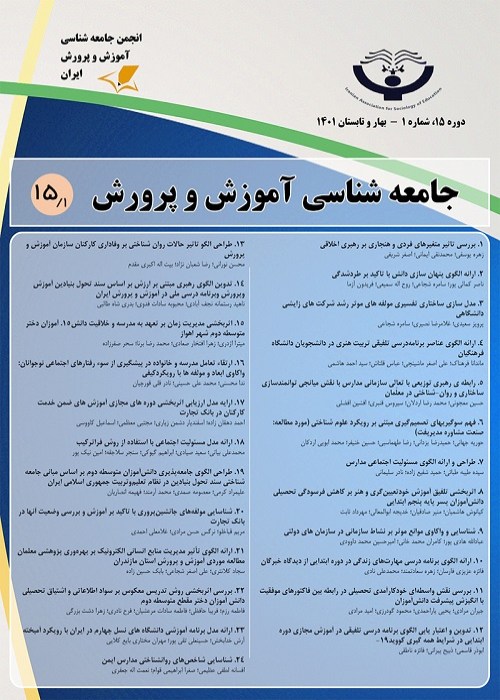Provide a Model of Entrepreneurship-Based Curriculum in Secondary School (Case study: Secondary Schools in Alborz Province)
The aim of this study was to provide a model of entrepreneurship-based curriculum in secondary school.
The present study was applied in terms of purpose and integrated (qualitative-quantitative) in terms of implementation method. The research population in the qualitative section included experts in the field of entrepreneurship in Alborz province in the academic year 2020-2021, in which 14 people were selected based on theoretical saturation method and purposive sampling. The statistical population of the quantitative section also included all secondary school teachers of Alborz planning and entrepreneurship course in the academic year 2020-21 (266 people). The sample size was determined based on Morgan and Georgian table and 154 people were selected by simple random sampling method. The research tool in the qualitative part was semi-structured interviews and in the quantitative part was a researcher-made questionnaire based on the findings of the qualitative part. To validate the qualitative data, a recoding strategy and reliability were obtained with a coding agreement coefficient of 0.86. For quantitative findings, face validity and reliability were obtained by Cronbach's alpha method of 0.82. For data analysis, in the qualitative part, the content analysis method was used with Maxquda18 software and in the quantitative part with exploratory factor analysis and structural equation modeling with Smart Pls3 software.
The findings of the qualitative section showed that there are 56 sub-themes and 5 main themes (entrepreneurial knowledge, entrepreneurial attitude, entrepreneurial skills and entrepreneurial ability) for the entrepreneurship curriculum. The results of exploratory factor analysis also showed that the first factor, ie the creation of entrepreneurial knowledge explains 6.54 of the total variance, the second factor (entrepreneurial attitude) 7.65%, the third factor (entrepreneurial skills) 12.76% and the fourth factor (entrepreneurial ability) 14.65% explained the total variance of entrepreneurship. The results of structural equation modeling also showed that all identified factors have a significant effect. The GOF criterion also showed that the overall fit of the model was at a desirable level.
It can be concluded that a good curriculum should pay attention to the factors of knowledge, skills, attitudes and abilities, and curriculum planners should pay more attention to "creating entrepreneurial ability" and "entrepreneurial skills" in designing the entrepreneurship textbook.
- حق عضویت دریافتی صرف حمایت از نشریات عضو و نگهداری، تکمیل و توسعه مگیران میشود.
- پرداخت حق اشتراک و دانلود مقالات اجازه بازنشر آن در سایر رسانههای چاپی و دیجیتال را به کاربر نمیدهد.


